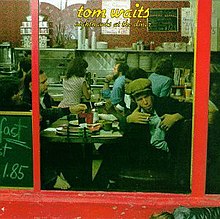Nighthawks at the Diner
| Nighthawks at the Diner | |||||
|---|---|---|---|---|---|
 |
|||||
| Live album by Tom Waits | |||||
| Released | October 1975 | ||||
| Recorded | July 30 – 31, 1975 Record Plant Studios |
||||
| Genre | Spoken word, jazz, singer-songwriter | ||||
| Length | 73:54 | ||||
| Label | Asylum | ||||
| Producer | Bones Howe | ||||
| Tom Waits chronology | |||||
|
|||||
| Tom Waits live chronology | |||||
|
|||||
| Professional ratings | |
|---|---|
| Review scores | |
| Source | Rating |
| Allmusic | |
| Mojo | |
| Robert Christgau | (B) link |
| The Rolling Stone Album Guide | |
| Sputnikmusic | |
Nighthawks at the Diner is the first live album by Tom Waits and his third overall. It was released on Asylum Records in October 1975. It was recorded live in the Los Angeles Record Plant Studios, in front of a small invited audience.
The album peaked at 164 on the Billboard 200, the highest place he had ever held at the time, and is currently certified Silver by the BPI. It has received critical acclaim for its successful mood-setting, capturing of the jazz-club atmosphere and characterisation. It is included in the book 1001 Albums You Must Hear Before You Die.
The title was inspired by Edward Hopper's 1942 painting Nighthawks. The album's working title had been "Nighthawk Postcards from Easy Street," but was shortened to Nighthawks at the Diner, which is the opening line to "Eggs and Sausage (In a Cadillac with Susan Michelson)". The cover, designed by Cal Schenkel, is also inspired by the painting.
The album was recorded at Record Plant Los Angeles on July 30 and 31, 1975. Waits opens the album by calling the venue Raphael's Silver Cloud Lounge.
Bones Howe, the album's producer, on the recording of the album:
We did it as a live recording, which was unusual for an artist so new [...] Herb Cohen and I both had a sense that we needed to bring out the jazz in Waits more clearly. Tom was a great performer on stage [...] So we started talking about where we could do an album that would have a live feel to it. We thought about clubs, but the well-known ones like The Troubadour were toilets in those days. Then I remembered that Barbra Streisand had made a record at the old Record Plant Studios, when they were on 3rd Street near Cahuenga Boulevard [...] There was a room there that she got an entire orchestra into. Back in those days they would just roll the consoles around to where they needed them. So Herb and I said let's see if we can put tables and chairs in there and get an audience in and record a show.
...
Wikipedia
